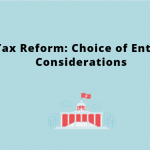Family business ownership succession and tax considerations for choosing an entity business structure
This is a follow up post to a previous article titled “7 strategies to make a family owned business succession transition work successfully”. And since there are many facets and complexities to managing succession of a family owned business, and determining things; such as leadership succession, will the next generation of the family pick up the torch, building a board function and more specifically the tax considerations for choosing or changing the business entity structure of the company for future growth.
Family businesses tend to be closely held, with one or a small number of shareholders maintaining control over the enterprise and the family’s investments. While this type of operating structure has many advantages, tight control can also lead to challenges with a transfer of ownership and responsibilities. Managing succession is a key component of business continuity planning yet it can be a complex task. As a result, sometimes families ignore the need to formalize a plan or they postpone the process.
There are many different ways to pass the family business to the next generation, but it is important to start by understanding your family culture and values, and defining a common purpose. This can help unite the family inside and outside the business. In this article, we discuss:
- Different approaches to succession planning for a family business.
- Strategies that we’ve seen successful families take to promote continuity within the business and the family.
- Effective ownership structures. Thorough succession planning should consider this, as family businesses can be organized in a variety of ways. These range from the relatively simple form of sole proprietorship to a more complex corporate structure.
- Considerations for a sale of the business, as this can be another outcome of business continuity planning.
Ownership Succession
A good succession plan should consider the most effective ownership structure for the business and revisit it regularly to determine whether adjustments or improvements should be made. Family businesses can be organized in a variety of ways. These range from the relatively simple form of sole proprietorship to the most formal structure, which is a corporation. Within that range there are also limited liability companies (LLCs) and partnerships. Many factors should be considered in choosing the best structure for a particular family’s business, both at the company’s inception and as the business evolves and matures. Prime considerations in choosing a structure include how it will affect the family’s ability to raise capital for the business, protect the business’s assets from creditors, limit owner liability, and preserve and transfer wealth to successive generations.
Tax considerations: It is important to weigh tax factors when determining the right ownership structure, including:
- What tax bracket are the principal owners in?
- What types of owners are expected to participate?
- Does the business expect to retain most of its earnings, or will it distribute them?
- Do the owners plan for any income, expense or credit allocations?
- Is the business generating, or expected to generate, either operating or capital losses?
- Will the income or losses generated be derived from passive activities?
- Should the business use a tax year different from that of its principal owners?
- What accounting methods are appropriate or desired for the business?
- What impact will employment tax obligations have on the business?
- Do owners need to limit their exposure to liabilities?
- What state tax treatments are applicable?
These questions should be carefully discussed with experienced tax advisors before a business determines or changes its structure. Structuring options: A family business generally prefers to adopt a structure that takes the potential for tax at two levels—the entity level and the ownership levels—into consideration. Many businesses choose a flow-through structure, such as an S corporation, partnership or limited liability company. S corporations are popular for many family businesses. They allow for the inclusion of family members who don’t participate in running the business and give owners the flexibility to facilitate the transfer of wealth via certain trusts. However, the rigid shareholder requirements of an S corporation can become problematic as the family grows. Similarly, as the generations spread geographically—across the country and around the globe—entire branches of the family may become disconnected. This can result in familial disaffection and operational problems. In some cases, it might make sense to consider switching to an alternative ownership structure, such as a C corporation. Recent tax changes are another reason a family business may consider an alternative ownership structure. Each family should consider many factors before making a change that is driven by tax reform, so consulting with your tax advisor is imperative. Last year we wrote an in-depth article about the recent Trump tax reform legislational impact on choice of entity and it specifically analyzed ‘C corporation versus flow-through entity’ business decision.
Some family businesses may opt to be structured as limited liability companies rather than as corporations. LLCs provide the benefit of limited liability for the owners, accompanied by much of the flexibility provided by partnerships. As with partnerships, LLCs allow for the flowthrough of losses to the owners. Before choosing a structure, a family business should first discuss with experienced advisors the pros and cons of each alternative. The general characteristics of the various types of business structures are summarized in a chart at the end of this chapter.
Overview comparison of entities
A new deduction for qualified pass-through business income is effective for tax years beginning after December 31, 2017. The pass-through entity’s operating agreement would provide a 20% deduction for qualified business income from a partnership, S corporation, or sole proprietorship. The 20% deduction combined with a top ordinary income tax rate of 37% for individuals would result in a top rate of 29.6% for such income in the absence of other limitations.
In addition, for taxable years beginning after December 31, 2017 and before January 1, 2026, business losses in excess of business income plus $500,000 (for married couples filing a joint return) would not be deductible for the current tax year. Such losses would be treated as a net operating loss (NOL) carryforward to subsequent taxable years. This limitation would apply after the application of the passive loss rules under Section 469. This provision would limit the ability of taxpayers to use large business losses to offset other income in their returns (e.g., wages, interest, dividends, capital gains). These new rules are very complex and should be discussed with a tax advisor before any restructuring is done.
Tax Consideration Overview Comparison of Entities
| Entity Type | Partnership | S corporation | C corporation | LLC |
|---|---|---|---|---|
| Liability | Unlimited for general partners |
Limited to amounts invested and loaned |
Limited to amounts invested and loaned |
Limited to amounts invested and loaned |
| Double taxation | No | No (except for some built-in gains and passive income) |
Yes | No, unless election made to be treated as a C corporation |
| Flow-through of profits and losses |
Yes | Yes | No | Yes, unless election made to be treated as a C corporation |
| Limitation on entity losses deductible by owners |
Net investments plus net income plus share of debt |
Net investment plus net income plus loans to corporations |
None Deductible | Net investment plus net income plus share of debt |
| Subject to passive activity loss rules |
yes | Yes | Only certain small C corporations |
Yes |
| Tax rates (pre-Tax reform) |
Income taxed to owners at marginal tax rates, plus 3.8% on investment income* |
Income taxed to owners at marginal tax rates, plus 3.8% on investment income* |
15% on first $50,000, increasing to 34% over $75,000 and 35% over $10 million** |
Income taxed to owners at marginal tax rates, plus 3.8% on investment income* |
| Special allocations | Possible, if there’s a substantial economic effect |
No | Possible, if tracking stock is issued |
Possible, if there’s a substantial economic effect |
| Fiscal year | May be the year-end of majority interest or principal partners; alternatively, may be the tax year that provides the least aggregate tax deferral |
May end up to three months earlier than the yearend of principal shareholders |
New corporations— any fiscal year; Existing corporations— fiscal year with business purpose; automatic change permitted in certain circumstances |
May be the year-end of majority-interest or principal partners; alternatively, may be the tax year that provides the least aggregate tax deferral |
| Tax-free fringe benefits to owners | Limited | Limited | Permitted | Limited |
| Public offering | Yes, but with some complexity |
No | No | Yes, but with some complexity |
| Tax-free merger with corporations |
Yes, under certain circumstances; additionally, possible tax-free incorporation available |
Yes | Yes | Yes, under certain circumstances; additionally, possible tax-free incorporation available |
| Accumulated earnings tax | No | No | Yes | No |
* The additional 3.8% tax applies to the lesser of net investment income or modified adjusted gross income that exceeds $250,000 for married couples filing jointly, $125,000 for married couples filing separately, and $200,000 for individuals.
** 21% flat rate for tax years beginning in 2018












